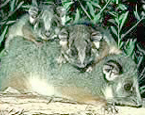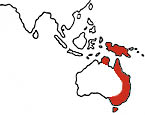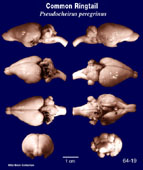|
Common
Ringtail
(Pseudocheirus peregrinus) #64-19 |
||||
|
| Physical
characteristics and distribution |
|
Common
Ringtails are the smallest of eight species of ringtail possums
that live in Australia. The adults of this species typically
are between 30 and 35 cm in body length, with a tail length
that is roughly equal to the body length. They have brown or
reddish fur on the upper surfaces of the body and light colored
or gray fur on the ventral surfaces, with large eyes which are
well adapted to seeing at night. Two of the claws found on the
front feet are opposable and the pads, as well as the tips,
of the toes are grooved. They possess a strong, but relatively
hairless, prehensile tail. This tail is carried tightly curled
when not in use. These animals can be distinguished from other
possum species in several ways. Their ears are smaller and more
rounded and they typically have patches of white fur both on
and above the ears. The tail of Common Ringtail has a white
tip and is tapered. Common Ringtails are nocturnal and primarily folivorous. They feed mainly on eucalyptus leaves, but may also eat flowers, buds, nectar, and fruit. A low metabolic rate helps to compensate for the low energy intake of these mammals due to their specialized diet. Common ringtail possums prefer eating the youngest foliage of the plants they consume. This effects reproductive patterns, as the young leave the pouch and are weaned during times when flower and fruit growth peaks. Breeding occurs from April - November with a litter of 2 young. The female's pouch has a forward facing opening; two of the four nipples are functional at one time. Older females can produce up to two litters of young per year. Initial growth of their young is generally slow. They habitat Australia: Cape York Peninsula (Queensland) to SE South Australia and SW Western Australia, Tasmania, and islands of the Bass Straits. |
|
Description
of the brain
|
|
Animal
source and preparation
|
|
All
specimens collected followed the same preparation
and histological procedure.
|
Other Related Resources (websites and publications)
List of Specimens | Explore Collections | Brain Sections | Brain Evolution | Brain Development | Brain Circuitry | Brain Functions | Location and Use | Related Web Sites | Contact Us | Search MSU Database | Personnel | Home



